Nan Zhang
Kinematically Controllable Cable Robots with Reconfigurable End-effectors
Oct 26, 2025Abstract:To enlarge the translational workspace of cable-driven robots, one common approach is to increase the number of cables. However, this introduces two challenges: (1) cable interference significantly reduces the rotational workspace, and (2) the solution of tensions in cables becomes non-unique, resulting in difficulties for kinematic control of the robot. In this work, we design structurally simple reconfigurable end-effectors for cable robots. By incorporating a spring, a helical-grooved shaft, and a matching nut, relative linear motions between end-effector components are converted into relative rotations, thereby expanding the rotational workspace of the mechanism. Meanwhile, a bearing is introduced to provide an additional rotational degree of freedom, making the mechanism non-redundant. As a result, the robot's motion can be controlled purely through kinematics without additional tension sensing and control.
Understanding the Thinking Process of Reasoning Models: A Perspective from Schoenfeld's Episode Theory
Sep 18, 2025Abstract:While Large Reasoning Models (LRMs) generate extensive chain-of-thought reasoning, we lack a principled framework for understanding how these thoughts are structured. In this paper, we introduce a novel approach by applying Schoenfeld's Episode Theory, a classic cognitive framework for human mathematical problem-solving, to analyze the reasoning traces of LRMs. We annotated thousands of sentences and paragraphs from model-generated solutions to math problems using seven cognitive labels (e.g., Plan, Implement, Verify). The result is the first publicly available benchmark for the fine-grained analysis of machine reasoning, including a large annotated corpus and detailed annotation guidebooks. Our preliminary analysis reveals distinct patterns in LRM reasoning, such as the transition dynamics between cognitive states. This framework provides a theoretically grounded methodology for interpreting LRM cognition and enables future work on more controllable and transparent reasoning systems.
TaxoAdapt: Aligning LLM-Based Multidimensional Taxonomy Construction to Evolving Research Corpora
Jun 12, 2025Abstract:The rapid evolution of scientific fields introduces challenges in organizing and retrieving scientific literature. While expert-curated taxonomies have traditionally addressed this need, the process is time-consuming and expensive. Furthermore, recent automatic taxonomy construction methods either (1) over-rely on a specific corpus, sacrificing generalizability, or (2) depend heavily on the general knowledge of large language models (LLMs) contained within their pre-training datasets, often overlooking the dynamic nature of evolving scientific domains. Additionally, these approaches fail to account for the multi-faceted nature of scientific literature, where a single research paper may contribute to multiple dimensions (e.g., methodology, new tasks, evaluation metrics, benchmarks). To address these gaps, we propose TaxoAdapt, a framework that dynamically adapts an LLM-generated taxonomy to a given corpus across multiple dimensions. TaxoAdapt performs iterative hierarchical classification, expanding both the taxonomy width and depth based on corpus' topical distribution. We demonstrate its state-of-the-art performance across a diverse set of computer science conferences over the years to showcase its ability to structure and capture the evolution of scientific fields. As a multidimensional method, TaxoAdapt generates taxonomies that are 26.51% more granularity-preserving and 50.41% more coherent than the most competitive baselines judged by LLMs.
Multimodal Machine Translation with Visual Scene Graph Pruning
May 26, 2025Abstract:Multimodal machine translation (MMT) seeks to address the challenges posed by linguistic polysemy and ambiguity in translation tasks by incorporating visual information. A key bottleneck in current MMT research is the effective utilization of visual data. Previous approaches have focused on extracting global or region-level image features and using attention or gating mechanisms for multimodal information fusion. However, these methods have not adequately tackled the issue of visual information redundancy in MMT, nor have they proposed effective solutions. In this paper, we introduce a novel approach--multimodal machine translation with visual Scene Graph Pruning (PSG), which leverages language scene graph information to guide the pruning of redundant nodes in visual scene graphs, thereby reducing noise in downstream translation tasks. Through extensive comparative experiments with state-of-the-art methods and ablation studies, we demonstrate the effectiveness of the PSG model. Our results also highlight the promising potential of visual information pruning in advancing the field of MMT.
Training Step-Level Reasoning Verifiers with Formal Verification Tools
May 21, 2025Abstract:Process Reward Models (PRMs), which provide step-by-step feedback on the reasoning generated by Large Language Models (LLMs), are receiving increasing attention. However, two key research gaps remain: collecting accurate step-level error labels for training typically requires costly human annotation, and existing PRMs are limited to math reasoning problems. In response to these gaps, this paper aims to address the challenges of automatic dataset creation and the generalization of PRMs to diverse reasoning tasks. To achieve this goal, we propose FoVer, an approach for training PRMs on step-level error labels automatically annotated by formal verification tools, such as Z3 for formal logic and Isabelle for theorem proof, which provide automatic and accurate verification for symbolic tasks. Using this approach, we synthesize a training dataset with error labels on LLM responses for formal logic and theorem proof tasks without human annotation. Although this data synthesis is feasible only for tasks compatible with formal verification, we observe that LLM-based PRMs trained on our dataset exhibit cross-task generalization, improving verification across diverse reasoning tasks. Specifically, PRMs trained with FoVer significantly outperform baseline PRMs based on the original LLMs and achieve competitive or superior results compared to state-of-the-art PRMs trained on labels annotated by humans or stronger models, as measured by step-level verification on ProcessBench and Best-of-K performance across 12 reasoning benchmarks, including MATH, AIME, ANLI, MMLU, and BBH. The datasets, models, and code are provided at https://github.com/psunlpgroup/FoVer.
Online Functional Principal Component Analysis on a Multidimensional Domain
May 04, 2025
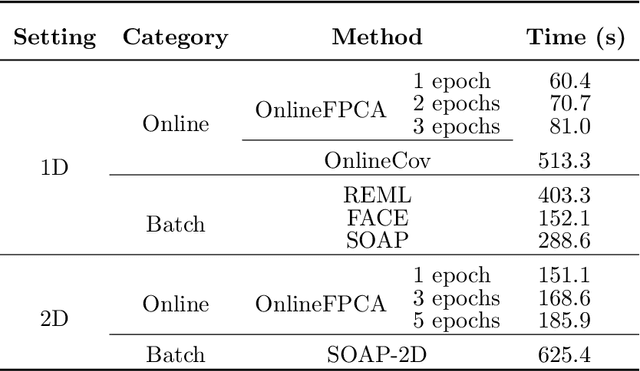

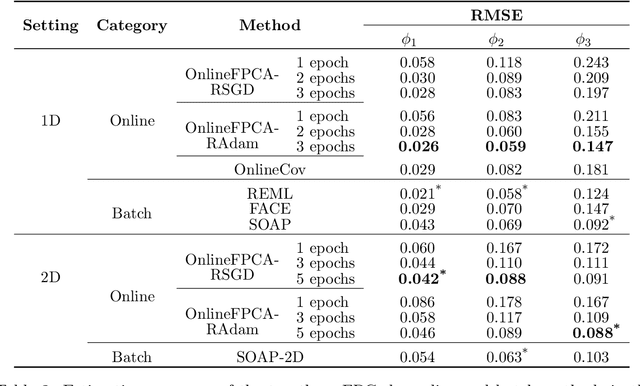
Abstract:Multidimensional functional data streams arise in diverse scientific fields, yet their analysis poses significant challenges. We propose a novel online framework for functional principal component analysis that enables efficient and scalable modeling of such data. Our method represents functional principal components using tensor product splines, enforcing smoothness and orthonormality through a penalized framework on a Stiefel manifold. An efficient Riemannian stochastic gradient descent algorithm is developed, with extensions inspired by adaptive moment estimation and averaging techniques to accelerate convergence. Additionally, a dynamic tuning strategy for smoothing parameter selection is developed based on a rolling averaged block validation score that adapts to the streaming nature of the data. Extensive simulations and real-world applications demonstrate the flexibility and effectiveness of this framework for analyzing multidimensional functional data.
HRScene: How Far Are VLMs from Effective High-Resolution Image Understanding?
Apr 29, 2025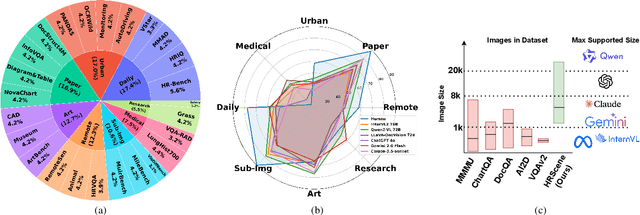
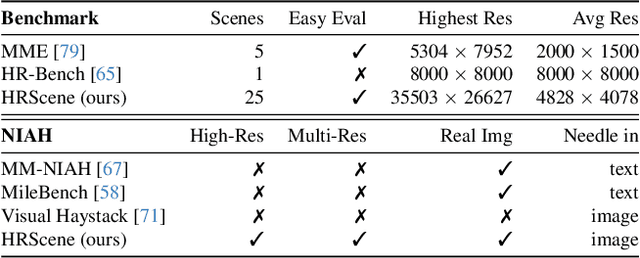
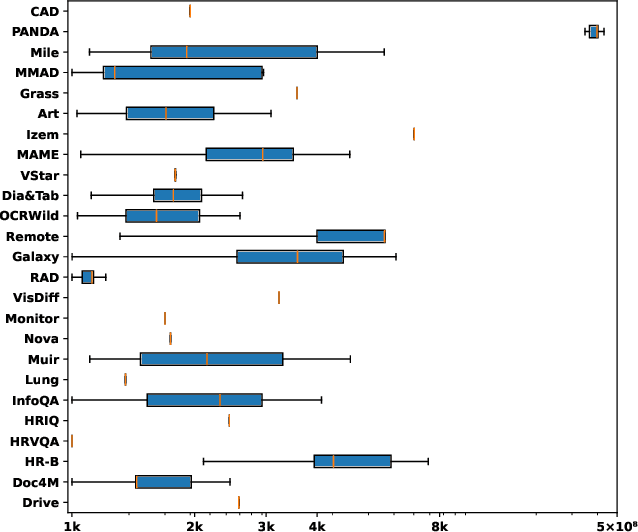

Abstract:High-resolution image (HRI) understanding aims to process images with a large number of pixels, such as pathological images and agricultural aerial images, both of which can exceed 1 million pixels. Vision Large Language Models (VLMs) can allegedly handle HRIs, however, there is a lack of a comprehensive benchmark for VLMs to evaluate HRI understanding. To address this gap, we introduce HRScene, a novel unified benchmark for HRI understanding with rich scenes. HRScene incorporates 25 real-world datasets and 2 synthetic diagnostic datasets with resolutions ranging from 1,024 $\times$ 1,024 to 35,503 $\times$ 26,627. HRScene is collected and re-annotated by 10 graduate-level annotators, covering 25 scenarios, ranging from microscopic to radiology images, street views, long-range pictures, and telescope images. It includes HRIs of real-world objects, scanned documents, and composite multi-image. The two diagnostic evaluation datasets are synthesized by combining the target image with the gold answer and distracting images in different orders, assessing how well models utilize regions in HRI. We conduct extensive experiments involving 28 VLMs, including Gemini 2.0 Flash and GPT-4o. Experiments on HRScene show that current VLMs achieve an average accuracy of around 50% on real-world tasks, revealing significant gaps in HRI understanding. Results on synthetic datasets reveal that VLMs struggle to effectively utilize HRI regions, showing significant Regional Divergence and lost-in-middle, shedding light on future research.
When Reasoning Meets Compression: Benchmarking Compressed Large Reasoning Models on Complex Reasoning Tasks
Apr 02, 2025Abstract:Recent open-source large reasoning models (LRMs) exhibit strong performance on complex reasoning tasks, but their large parameter count makes them prohibitively expensive for individuals. The compression of large language models (LLMs) offers an effective solution to reduce cost of computational resources. However, systematic studies on the performance of compressed LLMs in complex reasoning tasks, especially for LRMs, are lacking. Most works on quantization and pruning focus on preserving language modeling performance, while existing distillation works do not comprehensively benchmark student models based on reasoning difficulty or compression impact on knowledge and reasoning. In this paper, we benchmark compressed DeepSeek-R1 models on four different reasoning datasets (AIME 2024, FOLIO, Temporal Sequences of BIG-Bench Hard, and MuSiQue), ranging from mathematical to multihop reasoning, using quantization, distillation, and pruning methods. We benchmark 2.51-, 1.73-, and 1.58-bit R1 models that adopt dynamic quantization. We also benchmark distilled R1 models that are based on LLaMA or Qwen and run SparseGPT on them to obtain various sparsity levels. Studying the performance and behavior of compressed LRMs, we report their performance scores and test-time compute (number of tokens spent on each question). Notably, using MuSiQue, we find that parameter count has a much greater impact on LRMs' knowledge memorization than on their reasoning capability, which can inform the choice of compression techniques. Through our empirical analysis of test-time compute, we find that shorter model outputs generally achieve better performance than longer ones across several benchmarks for both R1 and its compressed variants, highlighting the need for more concise reasoning chains.
MFH: A Multi-faceted Heuristic Algorithm Selection Approach for Software Verification
Mar 28, 2025Abstract:Currently, many verification algorithms are available to improve the reliability of software systems. Selecting the appropriate verification algorithm typically demands domain expertise and non-trivial manpower. An automated algorithm selector is thus desired. However, existing selectors, either depend on machine-learned strategies or manually designed heuristics, encounter issues such as reliance on high-quality samples with algorithm labels and limited scalability. In this paper, an automated algorithm selection approach, namely MFH, is proposed for software verification. Our approach leverages the heuristics that verifiers producing correct results typically implement certain appropriate algorithms, and the supported algorithms by these verifiers indirectly reflect which ones are potentially applicable. Specifically, MFH embeds the code property graph (CPG) of a semantic-preserving transformed program to enhance the robustness of the prediction model. Furthermore, our approach decomposes the selection task into the sub-tasks of predicting potentially applicable algorithms and matching the most appropriate verifiers. Additionally, MFH also introduces a feedback loop on incorrect predictions to improve model prediction accuracy. We evaluate MFH on 20 verifiers and over 15,000 verification tasks. Experimental results demonstrate the effectiveness of MFH, achieving a prediction accuracy of 91.47% even without ground truth algorithm labels provided during the training phase. Moreover, the prediction accuracy decreases only by 0.84% when introducing 10 new verifiers, indicating the strong scalability of the proposed approach.
AutoTestForge: A Multidimensional Automated Testing Framework for Natural Language Processing Models
Mar 07, 2025Abstract:In recent years, the application of behavioral testing in Natural Language Processing (NLP) model evaluation has experienced a remarkable and substantial growth. However, the existing methods continue to be restricted by the requirements for manual labor and the limited scope of capability assessment. To address these limitations, we introduce AutoTestForge, an automated and multidimensional testing framework for NLP models in this paper. Within AutoTestForge, through the utilization of Large Language Models (LLMs) to automatically generate test templates and instantiate them, manual involvement is significantly reduced. Additionally, a mechanism for the validation of test case labels based on differential testing is implemented which makes use of a multi-model voting system to guarantee the quality of test cases. The framework also extends the test suite across three dimensions, taxonomy, fairness, and robustness, offering a comprehensive evaluation of the capabilities of NLP models. This expansion enables a more in-depth and thorough assessment of the models, providing valuable insights into their strengths and weaknesses. A comprehensive evaluation across sentiment analysis (SA) and semantic textual similarity (STS) tasks demonstrates that AutoTestForge consistently outperforms existing datasets and testing tools, achieving higher error detection rates (an average of $30.89\%$ for SA and $34.58\%$ for STS). Moreover, different generation strategies exhibit stable effectiveness, with error detection rates ranging from $29.03\% - 36.82\%$.
 Add to Chrome
Add to Chrome Add to Firefox
Add to Firefox Add to Edge
Add to Edge